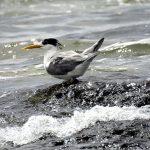GREATER CRESTED TERN
The Greater Crested Tern has a broad habitat range along the Australian coastline. These birds are commonly spotted from the picturesque shores of Queensland, stretching across the northern territories, and down the western coast to the cooler waters of South Australia and Tasmania. They are coastal dwellers, preferring sandy beaches, islands, and estuaries, where the dance between land and sea creates a bounty of feeding opportunities.
The breeding season of the Greater Crested Tern is a spectacle of nature’s design. They are colonial nesters, often sharing their breeding grounds with other seabird species. The breeding sites are typically on islands or isolated beaches, providing a safer environment for their offspring. The nests are simple scrapes in the sand, sometimes lined with bits of vegetation or debris. Each clutch usually comprises one, sometimes two, speckled eggs, which both parents diligently incubate.
After about three weeks of incubation, the chicks hatch. These fluffy inhabitants of the sandy nurseries are semi-precocial, meaning they are relatively mature and mobile from the moment they hatch but still rely on their parents for food and protection. The parents work tirelessly, soaring over the ocean to catch fish and returning to feed their hungry offspring. Despite their widespread distribution, these birds are remarkably faithful to their breeding sites, often returning to the same spot year after year to raise their young.
The Greater Crested Tern has an impressive lifespan, with some individuals reaching up to 30 years of age. This longevity is a testament to their resilience and adaptability in the ever-changing coastal environments they inhabit.
The vocal repertoire of the Greater Crested Tern is as vibrant as their lifestyle. Their calls are a chorus of harsh, raspy sounds, often described as a ‘kraak’ or a ‘kree-ar’. These vocalisations serve various purposes, from communication within the colony to the intimate exchanges between mates and their chicks. The sounds of a Greater Crested Tern colony are a defining feature of Australia’s coastal soundscapes, encapsulating the essence of the wild shores they call home.
The Greater Crested Tern is a master of the air and sea, capable of diving from great heights to snatch fish from the water with remarkable precision.
The sleek, black cap and the sharp, yellow bill of the Greater Crested Tern make it one of the more easily identifiable seabirds along the Australian coast.
While the Greater Crested Tern is currently not considered endangered, their reliance on specific coastal habitats makes them vulnerable to threats such as habitat destruction, pollution, and climate change. Protecting these birds means safeguarding the beaches, islands, and waters they depend on—a reminder of the interconnectedness of all life and the importance of conservation efforts.
In sharing the story of the Greater Crested Tern, we are reminded of the beauty and complexity of Australia’s natural heritage. These birds are not just inhabitants of our coasts; they are symbols of resilience, adaptability, and the untamed spirit of nature itself. By understanding and appreciating their lives, we take a step closer to ensuring that the symphony of Australia’s wildlife continues to flourish for generations to come.

















